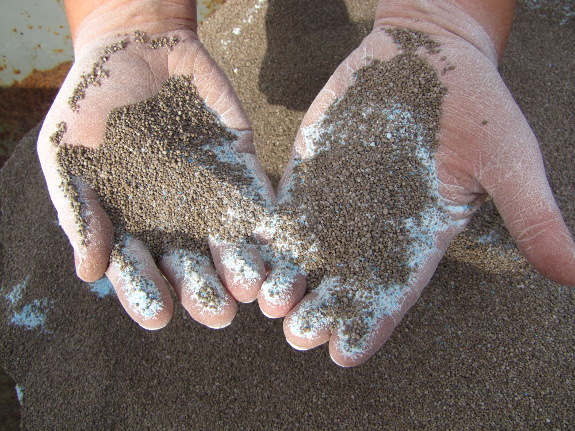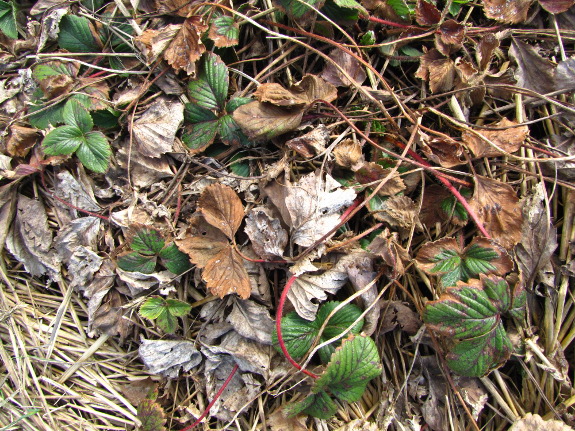
Remineralization revisited
 "I was wondering if you could clarify your
comment about being
on the fence about ratios vs. absolute quantities. Based on your earlier
mineralization posts, I'm supposing that you're on board with balancing
ratios and on the fence about the absolute quantities. Frankly,
I love testing my garden soils, but I'm an environmental
scientist and a data nerd
"I was wondering if you could clarify your
comment about being
on the fence about ratios vs. absolute quantities. Based on your earlier
mineralization posts, I'm supposing that you're on board with balancing
ratios and on the fence about the absolute quantities. Frankly,
I love testing my garden soils, but I'm an environmental
scientist and a data nerd  I tried Solomon's
remineralization techniques this year but didn't notice
any stellar gains in plant performance. My TCEC is rather low
(5-6) so I'm applying bentonite clay and biochar to help boost
nutrient retention. I'll give it a few more years. To me, the
soil test is a crucial step towards establishing healthy,
balanced soils."
I tried Solomon's
remineralization techniques this year but didn't notice
any stellar gains in plant performance. My TCEC is rather low
(5-6) so I'm applying bentonite clay and biochar to help boost
nutrient retention. I'll give it a few more years. To me, the
soil test is a crucial step towards establishing healthy,
balanced soils."
As you rightly
remember, I also followed Solomon's remineralization lead this
spring, and (although I haven't posted here yet about the
results), I was disappointed. Part of my disappointment
came because the
applied minerals burned the plants I had growing at the time (there's no true fallow
season in our garden), which may be due to the way I added
micronutrients in chemical form. I'm okay with a short-term decline, though, if I
see long-term improvements...but I didn't. In fact, not only
was there no flavor improvement, there actually seemed to be a
decrease in growth (although that's likely due to the cool and
overcast summer we had). As John
commented on the same post you reacted to, I might get
better results from more natural nutrient sources, like seaweed.
 On the other hand, I'm not
100% sold on nutrient balancing being important. The concept
makes intuitive sense, especially if you look at the way ions are
pumped into cells. But I haven't delved deeply enough into
the scientific literature to discover whether there are any solid
studies supporting Solomon's hypotheses.
On the other hand, I'm not
100% sold on nutrient balancing being important. The concept
makes intuitive sense, especially if you look at the way ions are
pumped into cells. But I haven't delved deeply enough into
the scientific literature to discover whether there are any solid
studies supporting Solomon's hypotheses.
In the meantime, I'll probably test my soil again this fall to see
how the numbers look post-remineralization. And hopefully
next summer will be a more regular season, so I'll get a better
idea of how the garden is doing. Until then, I'm not ready
to recommend for or against remineralization, so I remain dubious.
Want more in-depth information? Browse through our books.
Or explore more posts by date or by subject.
About us: Anna Hess and Mark Hamilton spent over a decade living self-sufficiently in the mountains of Virginia before moving north to start over from scratch in the foothills of Ohio. They've experimented with permaculture, no-till gardening, trailersteading, home-based microbusinesses and much more, writing about their adventures in both blogs and books.
Want to be notified when new comments are posted on this page? Click on the RSS button after you add a comment to subscribe to the comment feed, or simply check the box beside "email replies to me" while writing your comment.

Dear Anna: as a would-be homesteader and blogger, I was wondering what your normal day on the homestead looks like in terms of time spent in the garden versus online blogging or documenting your experiences? I'm sure it varies according to the season, but I am still curious as to what a typical day looks like for you and Mark. Thanks! Karen CleanKarma. org
You probably are faced with two problems in determining if your attention to minerals is worthwhile: [a] the small effects of mineral improvements may be masked, as you mention, by other more important factors like weather, and [b] your metric to determine improvement may be too insensitive. Taste probably has little to do with mineral content and yields from relatively small plots may show a wide "probabilistic variance," losing the effect as noise in the data.
If the effects are indeed small, one has to wonder if the extra time, effort & expense of dealing with the situation is worthwhile if you're not a commercial farmer trying to optimize input vs yield.
Hi Anna and Mark and all,
One of the more interesting things I have read/listened to is a series of 'old' consultants talking about what works. I can't remember if it was John Frank's or Bob Pike's site.
But both of the consultants were asked what measurement they looked at first when growth was below standard. (They had been called in because things WEREN'T growing!)
Both said conductivity!! That got my attention.
I am an engineer. So I have designed and built several conductivity measuring prototypes.
From what I see this measurement may be useful. You can certainly see things you cannot see any other way. And the signals are big and clear.
A recent rainstorm raised the soil conductivity in my test garden by 7 times.
I suspect that much of the soil conductivity is NOT due to salt type conduction, but due to soil fungi and microbes. I haven't figured out a good way to prove this?
Anyways, I continue to measure and learn.
1/4 teaspoon of pro-start in a 4 inch plant increases conductivity by over 10 times. Over time it goes down and eventually you can see symptoms on the plant.
So after you see it go down a bunch, you apply some more 'stuff' to fix the problem, etc.
So this measurement looks hopeful. Maybe.
Lots of fun.
John